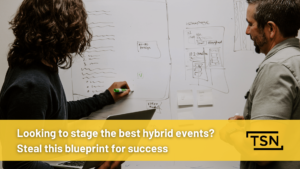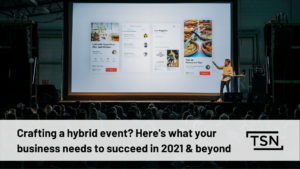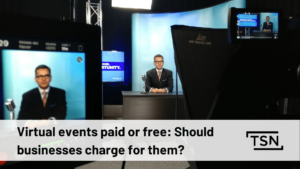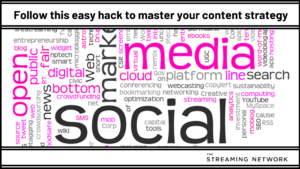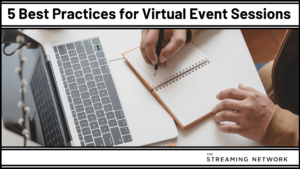Podcast: Play in new window | Download | Embed
Subscribe: Apple Podcasts | Google Podcasts | RSS
Lessons From The Frontline: How I Learned to Live with Never Getting a Second Chance with Live Virtual Events
In our last episode, we discussed different ways to add Thought Leadership strategies into our webinar program. We also dove into current target marketing trends. There are many industries that leverage accredited webinar content and not just for the financial sector. Today we will be focusing on legal marketers, specifically on how they have leveraged webinars incorrectly.
In our ninth episode, we are discussing:
- Challenges That Legal Marketers Face: Why deep data integration with a full-service webinar platform is important.
- What A Strong Legal Webinar Looks Like: The importance of establishing oneself as a Thought Leader.
- How Legal Marketing Firms Have Used Webinars Incorrectly: The conversation does not stop when a webinar event ends. Remarketing is imperative to the success rate of a strong webinar program.
The Complete Video Transcript
Peter Vamos: Webinars are hot. As a content marketing professional, I’ve produced hundreds of videos for social and traditional media platforms and currently work with one of the largest podcast networks in the country. So, for me, understanding how webinars work in the B2B space is both essential to my professional development and an exciting form of content creation.
According to a study commissioned by digital agency Demand Wave, 41% of B2B marketers cite webinars as the best marketing tactic for driving revenue.
I’ve set out to discuss webinars with one of the foremost experts in the field, Matt Ley, President of The Streaming Network in Toronto. Together, we’ve created this multi-part series of videos and podcasts, The Webinar: Lessons From The Front Line or How I Learned To Live With Never Getting A Second Chance With Live Virtual Events.
Welcome back to the webinar Lessons From The Front Line. With me, as usual, is Matthew Ley, President of The Streaming Network, Canada’s top webinar service provider.
The legal sector seems to march to the beat of its own drummer, preferring to do most if not all business in person. This seems to be in proud defiance of what is going on with the rest of the business community. And the evidence suggests that they are doing just fine without webinars, at least if you ask partners in law firms that do not do webinars.
But, lately, things have begun to shift. Legal webinars are on the rise across North America.
Matt Ley, welcome back.
Matthew Ley: Thank you, Pete.
Peter Vamos: So, what’s the difference about law firms than other professional services that you work with?
Matthew Ley: Well, you know what? One thing off the top, you had said that these lawyers will say that everything’s fine, but that is actually not true and probably one of the reasons why webinars are on the rise. Most law firms consider flat revenue to be growth in this day and age. They’re having trouble continuing–without acquisition to continue to grow, so it is one of the reasons.
But, there’s a couple things that are very different about the legal profession or the way law firms are set up that make them different. One of which is that, in a law firm, the customer is used to and wants to be courted by the lawyer, and then on the flipside, lawyers don’t want to beg for business or ask for business. And so, you–in a conventional organization like mine, you host a webinar, and the sales reps cannot wait to get the leads, they cannot wait to follow all the people. We actually have to hold back those tier two and tier three leads and let marketing do their thing so we’re not calling people too early in their buyer’s journey.
But, at law firms, you can’t get anyone to call. The people who want to call them, the business development specialists, part of the marketing department, no one wants to hear from them.
And so, for a while, the webinar was looked at this thing that they had to do because they weren’t getting as many bums in seats or they wanted to reach a new audience, but not really a tool that drove revenue or got ROI.
A few things have changed beyond the fact that they need to find new ways of driving revenue. We’ve seen, you know, law firms change their focus saying, “we’ve got to do something different,” and so we have to change the way we look at our buyer, bring in marketers from other sectors, and then a lot of times, they do actually come from accounting–a similar set up, partner environment, much more progressive in the use of webinars and really a lot of marketing techniques.
And a few years ago, PD (professional development) changed, and law firms started offering–had to offer–or didn’t have to but were able to offer a lot more PD to their customer, the corporate council at, you know, big companies like the banks. And when that happened, they started investing a little bit more in webinars itself.
Peter Vamos: You brought up accounting firms.
Matthew Ley: Yeah.
Peter Vamos: And obviously, there’s, you know, there’s differences, but there’s also things that you compare. So, they enjoy–when they dp webinars–.
Matthew Ley: –Yeah–.
Peter Vamos: –They enjoy many of the same sorts of benefits that other professional services enjoy.
Matthew Ley: Yes.
Peter Vamos: Let’s dive into that a little bit. How do law firms compare?
Matthew Ley: Well, I mean, law firms–you bring up other professional services, and, you know, our last podcast on financial services very similar–a lot of what they do is based around professional development. Lawyers, whether you like them or you don’t, have a lot to offer in the way of thought leadership or education. They can inform not just other lawyers on the impact of certain legalities, but accountants and HR professionals. And so, they’re often called upon to be the person to help, I guess, translate what’s going on in laws in this country.
And so, as a result, they get to offer PD in a lot of different ways, and PD is a big hook for people to come to events, and it’s a big hook for people to come to webinars. And so, they’re similar in that regard.
Another thing that’s similar about them is, as much as they are slow followers–and I’ll talk a lot today about, you know, how far they’ve come but still how far they need to go as it relates to webinars–we are seeing that their technology is moving away from just using legal tools, legal CRMs, legal marketing automation, legal this, legal that, to more standardized technology that plays well with other marketing tech like our webinar platforms or webinars in general.
But, you know, the really interesting thing is, if you go back to the viewership is legal webinars, if someone shows up, they generally stay just as long as anyone else till they’re at or above that 55 minute live viewership number. For on demand, they’ve always been above the norm as far as how long people will attend. And their conversion rates from registrant to viewer are higher than most any other segment that we deal with.
So, although we maybe don’t see as much action in legal webinars as we do in financial services or accounting, they have a lot of–a lot of aspects of the programs that we do see are stronger than the average webinar in either of those other sectors.
Peter Vamos: But, obviously, there’s challenges.
Matthew Ley: Yeah.
Peter Vamos: They do face challenges. What are some of the biggest challenges that law firms face in this area?
Matthew Ley: A lot of them are financial or–maybe not financial but I guess it’s the value that the–the value people put on the programs. So, in most law firms, you’ll deal with a small cross functional marketing team, the same people sending emails, doing webinars, hosting in person events. Some of the larger Seven Sisters firms will have events groups, marketing groups and sort of PD groups.
But–and, you know, you go below that, and they have to do a lot. And even in the Seven Sisters firms–I don’t want to upset any of our customers here–everyone has to do–they have to do a lot, as well. So, they’ve got small teams.
And then when it comes to, you know, purchasing technology, if you will, for things like webinars, because they have not seen ROI–there’s so many reasons for that. You know, we talked about the difference in the way that a new customer comes to a firm in a law firm versus a conventional B2B business–but, also, because they haven’t had the data or the analytics or the information for it, it’s hard for a lot of marketers or event teams in the legal profession to get budget to do a webinar program right.
Peter Vamos: Right.
Matthew Ley: They have partners. It’s their money. Every dollar that goes into a marketing, that comes out of a partner’s pocket. They’re all contributing to this–or practice group leader is contributing to it. And so, if you can’t show them that straight line to how it’s gonna impact them, it’s harder. It’s often times not a centralized buyer making that decision.
And so, with all those things working against them, even some of the firms that have been–were early adopters are struggling to expand, you know, kind of the programs.
Peter Vamos: Right.
Matthew Ley: Those challenges are things that I’ve seen for 10 years. I’m starting to see a change based around necessity. We have to do something different. We have to compete with these guys over here. And as such, they are growing, but they’ve got a long ways to go.
Peter Vamos: Right. There’s I guess a lot of just–with all these other businesses you’ve got, the consumer is really doing all the internet research.
Matthew Ley: Yeah.
Peter Vamos: They’re doing all that sort of stuff ahead of time. These are the exact sorts of challenges that all these other sectors face, as well, that all the research is done before they ever engage.
Matthew Ley: No.
Peter Vamos: No?
Matthew Ley: So, my understanding is that it’s a little different than that.
Peter Vamos: Right.
Matthew Ley: I’m hearing the number one way that firms get new clients is through the referral basis, and the reason that top firms are investing in content and Webinars and putting all of this out there is to show the value that they bring to a perspective new customer. So, I refer you to my lawyer, and you go there, and you’re having a problem with, I don’t know, the Panama Papers. You got money overseas or something like that, and you’re trying to figure it out.
And you go there and there’s these great articles or this Webinar that explains what’s going on, and you’re like, “Oh, if only my lawyer had told me that, you know, I would have do it. But, in saying that, what’s funny is that the number one place that I find law firms find their Webinar, Virtual Event, Webcasting partner from is not from doing research but from other people in legal marketing. So, they talk to each other, and that’s how we’ve gotten a lot of our customers. You know, we’re doing–we do stuff like this or whatever. We get some leads this way, but really it’s them talking to each other and then sort of giving a call.
There are another one of these industries, not unlike–I was mentioning financial services–where they happen to look inward a lot rather outward, and there’s a lot of movement between the firms, which can be a barrier to progress, change and innovation.
Peter Vamos: Interesting. I guess that also speaks then yet to once you get a client, there’s a lot of loyalty there–
Matthew Ley: –Yes.
Peter Vamos: –as well, which is probably a big part of it. Obviously there’s–you’re making a big push right now. How has TSN’s approach changed in the last 12 months towards the sector?
Matthew Ley: Yeah. I think what we’ve done, in general, and this might sound a little harsh, is we–you know, we’re Canada’s largest provider of these services. We talk to law firms all the time. We just decided that we are recognizing when it’s right to talk to us and when it’s not. So, if you’re looking, you know, to get into a Webinar program and we hear from you, we start talking about what’s important to you, and nothing that’s important to you makes sense to us in that you’re not looking at–data doesn’t matter. You know, this doesn’t matter. That doesn’t matter.
You’re probably not the right customer for us.
And so, we’ve done the walk away, but we’ve really invested in those firms that are focusing on what we think to be the right thing. So they’re focusing on the data and integration. They’re trying to find ways of improving the experience of their customers. So, it’s easier for them to access their content. They’re trying to transform what has been typically everything done this way, and they’re trying to break that nasty habit of, “We’ve always done it this way, so this is the way we’re going to do it now and move the organization forward.”
When we find a law firm like that, we throw a lot of resources at them, not just sales resources. We want to go out and we want to help these firms become the beacon of what can be done. Because interestingly, when we first started talking about engagement scoring or profiling the top, you know, 5 or 10 or 20 or 100 viewers or whatever it might be, and everything that we’ve now effectively applied to the conventional B2B space–initially when we–when this started being built and we started launching it, I was most excited about law firms, because we knew the lawyer wasn’t going to–there was no mechanism by which to follow up with the 250 or so viewers they got and try and convert that to revenue.
But the lawyer–if you could pick out those five people that were so focused on the topic of the Panama Papers, they ask five questions, they downloaded six resources, that they would actually pick up the phone or at minimum, send an email and start an engagement with them. And we know from experience that you get a practice group leader who gets a call after a Webinar and picks up a significant customer–it was the case for one of our first customers, their first Webinar.
They got a bunch of business from Wal-Mart in Canada. And it just spreads like wildfire. This is magic. It will get you customers like other programs won’t. And so, I was so excited about that. It didn’t really resonate as well as I had hoped. And so, when you see someone who it does resonate for and we get excited, we will go in and we will invest all of our–a lot of energy into those programs to get them going and off the ground.
Peter Vamos: Right. Let’s talk a little bit–we talked when we were talking financial services about the continued education.
Matthew Ley: Yeah.
Peter Vamos: So, let’s talk a little bit about that, and how does that apply with this sector?
Matthew Ley: So, they call it PD, but so many things are similar, yet so many things are different about it. But, so, they call it professional development, and that’s because the primary buyer of legal services is corporate council, when you’re in sort of that B2B space. So, they offer continued legal education out to their customers.
In many cases they’re in hidden programs, meaning that they’re only for customers, and so they’ll do it for a select group of people as a value for being part of the firm. But, they also have to service the 200, 100, 10, 50 thousand lawyers that they employ because everyone needs those credits now. And so, they’ll have these robust PD departments so they don’t have to pay for external training or external credits, and they’ll be delivering these programs.
So, as much as they’re similar to financial services, they actually have more they need to do than financial services from a PD perspective.
But, they treat internal and external completely different. And as such, you’ll have–one firm that I’m talking to right now has a very robust internal way of tracking everything they do for the internal folks. But, for the externals, they have nothing because they can’t convert that. And so, the PD team has nothing going with the external, even though that’s becoming an increasingly large part of their overall PD program. Or, they will put all this effort into the external in most cases and have these really great assets that are there for them, and then on the internal, they’ll do things that, you know, are, you know, really, really like subpar because it’s like only our internal side. And almost every place we go they’re on different platforms.
Peter Vamos: Right.
Matthew Ley: We’ll go in and we’ll work with the marketers, and we’ll find out that PD is doing something different. And so, CE Central built for financial services answers that problem for the law firms as well, a centralized place that houses data on accredited–accreditation for in-person, third party and our application, making sure that PD department can easily, sort of, run reports on who’s been accredited and who hasn’t and improve the experience of their customers, because they know they can go and get that credit information.
Even if legal is not the same as financial services where they don’t, maybe, have to report as often about it, it’s still a service that is valuable to them and fixes a lot of problems.
Peter Vamos: That’s great. So, we’ve talked about a lot of things. But, then one thing we actually haven’t talked about is, you know, what a good, strong legal Webinar looks like.
Matthew Ley: Yeah.
Peter Vamos: So, let’s dive into that a bit. What are we looking at here?
Matthew Ley: So, a strong legal Webinar program has a current and reliable PD element to it. So, if case law are being augmented or changed, you know things are coming up, they are constantly delivering content that’s new and on point with the current case law.
CASL has always been a great draw for Webinars. Just because you did one four years ago and it got a lot of views doesn’t mean it’s even current anymore or three years ago, even a year ago. Laws change. The world changes.
And so, you want to be current with that program, and people need to be able to depend on you that when something is going to change, they can come to you for it or else they will go somewhere else. And from a thought leadership perspective or what we would consider traditional Webinars that may be out there trying to bring in new customers to the firm or whatever it is, is that they’re purposeful.
So, you know, we’ve been saying this. We’ve seen it.
And the firms that are doing well are doing it is if you’re looking to attract cross border business, people moving into Canada, you might have to fly down and see them or they might fly up and see you.
That’s a big investment and a lot going on. Hosting Webinars lets you get into that business, let them see and hear from your thought leaders, your partners, the guys that are going to be working with them. It might be a situation where you’re really strong in one or two practice groups, and you have emerging sectors in other ones or you’re strong in Alberta and Energy, not so strong in Toronto, that you do a Webinar on Energy from this practice group leader and target your Toronto audience who is not going to go out there to meet that guy in person like you want him to. And he only comes to Toronto when he has to because he loves living in Alberta or whatever the story is.
And so, these purposeful programs that fill gaps and just help you cross pollinate within your client base or attract new customers that you couldn’t reach by shaking hands and being in the room, those programs are always the ones that get the highest return on investment.
And then the last thing that I would say is the most–if you go to a firm–there’s a lot of firms out there that hide almost their entire program. It’s behind closed doors, and it’s exclusive content for their customers. And while I fully understand the aspect of exclusive content, there should also be content that is not. No one out there is going to know how awesome you are or your perspective if you hide it from the world. And there are programs out there that are completely hidden right now.
I still don’t understand it, and it can’t be explained to me in a way that makes sense. And so, the strong programs, the ones that are getting the most out of it, both for I think their customers and for the business and definitely the ones who I know are getting the highest ROI, because they’re the ones that are continuing to book more, have a massive public face for their Webinar programs.
Peter Vamos: That’s interesting. You mentioned–one of the things you mentioned was current [unintelligible]. And I know–I mean things are constantly changing. Technology is constantly changing. You have to stay up to date. In the last 12 months what were the biggest advancements you’ve seen as related to this sector?
Matthew Ley: Well, I’ve started to see a movement away from–there’s been–law firms didn’t use CRM’s. They used practice management software, which was basically a CRM with another layer in it. And there was one company out there, Lexus Nexus, that owned the market. Because they owned the market, because they had the data that fed into the case law data, the product what became old–it was a little bit closed up and it was–and basically, you know, limited what they could do from a technology perspective.
So, Lexus Nexus knew that this change was coming.
They bought a company called Future or launched a product–I forget what happened–but basically out of market automation tool. Started getting some, sort of, connectors and then started opening themselves up, which was nice. Now law firms could start looking at other technologies. And what is most exciting recently is just, you know, seeing people buck the conventional legal technology space and looking out at what everyone else is doing and saying, “Hey, you know, when I was at Deloitte, I was on Salesforce, and that worked really well. I’m going to try and bring that into a law firm.”
And we’re seeing that right now. It’s not just Salesforce. It’s called One Place.
It’s got a different skin on it, but still, so that technology is changing and is advancing. And, also, I mean like every business we talk to, the buyer demo is changing as is the thought leader demo. It’s not just the older lawyers who are thought leaders in certain subjects. It’s younger ones. And as that occurs, we’re seeing some–you know, a lot of firms starting to take chances that we wouldn’t expect. In some cases too many chances but that it is new.
So, there is change on the horizon, even with all the barriers that are in place, and I think it’s being driven by, in many cases, the technological transformation occurring within the firm that is long overdue and will allow for them to take advantage of a tool like a Webinar.
Let me just–I know I’ve been going on, but let me just say this. In the past with the type of tool products that they use due to budget constrictions, due to the access of information into their CRM, they would–many people I would talk to would literally run a Webinar, not know who attended it for two or three days and not even inform the CRM or the product management software that it happened, because they didn’t care.
They just stored it somewhere, and they just knew.
What traditional marketer knows is that, you know, although the Webinar generally doesn’t sell you anything–you got those couple guys that reach out and you get quick revenue, but really it’s just part of the story is that with a properly integrated program into these various aspects the marketer can start to see the likelihood of someone not who isn’t a customer becoming a customer or the likelihood of a customer spending more money with the firm based around how many Webinars that they view or based around the interaction within the Webinar.
They can start automating those responses and those call to actions that we know the lawyer won’t do because they’ll have the data and the information in the right place. They’ll know if there’s four people–four different aspects of a firm–of a company–sorry–watching Webinars on a similar subject. They’ll be able to aggregate that quickly and know something is going on that they’re looking at us for this. And so, you know, with this change in technology, when done right the marketer themselves can have such a greater impact on the firm’s overall revenue, like we saw in the birth of the VP of marketing in–sorry–in like technology and all these other places where they got more budget than IT does now for technology.
It’s certainly not the case in legal.
And when they can see that and they can transform viewers to dollars, I think that is going to be the most exciting time for legal marketers. They probably have been waiting for it for a long time too.
Peter Vamos: When you talk about the ability to sort of track that sort of stuff, that doesn’t apply to every platform though, right? There’s probably a lot of legal people listening to this sort of going, “Oh, that’s interesting.”
Matthew Ley: No, I mean there’s a lot–I mean we’re the best. We track the data. You know that. I say that all the time. And it is true. We’re also not the cheapest. And go back to what I said before. You go out and you buy, you know, a live video Webcast from a company that has five employees. We see this all the time at some of the largest firms. And you’re running on a platform that doesn’t have a name. It’s not backed by, you know, Cisco or, in our case, .
And, yeah, you’re not going to get that kind of data. You’re not going to get reliable data. You’re not going to get that data at all.
But, you’re paying $3000 for what we charge maybe $10,000 for. It’s a stark difference. And often when we see that, we walk in and we can understand what’s driving things, again, about picking the right firms, because we got to say, “Look, I’m going to tell you that we are at least three times more than what you’re being charged right now.” So, yeah, there is a lot of legal marketers out there saying, “We don’t have anywhere near that amount of information.” We can’t tell who’s engaged, who’s not. We can’t get that into our CRM. It’s all a pain. And, unfortunately, that goes back to this idea that it’s not a technology that people want to invest in. But, it’s driven the other way, right?
As CRM’s marketing automation tools got more powerful, then the data from our Webinar tool got–was more easily actioned, right? You couldn’t always action it just by human. There was whatever, so you had to have that. And so, as they go down that road, they’ll see it as well. We know it’s coming. We see it at some of the firms.
Peter Vamos: Right. And I guess it all boils down to how committed you are to growing your business and clients come and go–
Matthew Ley: –I watch that, you know, that term because, you know, legal marketers are committed. They’re just spending their money–they have limited budgets, and they’re spending it on things they know work.
Peter Vamos: Right.
Matthew Ley: But, in the background, IT is changing infrastructure. Websites are becoming updated. There’s things that are happening. And as that happens, then I think what they’ll see is that it will be–it will make more sense to spend that 10 grand on a Webinar that–or program or whatever with us then it would be with the other guy, even though it’s cheaper, because of that data flow. It’s going to switch for them.
Peter Vamos: It’s interesting too–we’re nearing the end, but one of the things I do want to ask you about is, you know, a lot of the clients–you imagine that they are much–sort of the bigger clients.
Matthew Ley: Yeah.
Peter Vamos: They’re employing this kind of technology because they do have the resources and they do have the people around them. A lot of lawyers are busy, right? They spend all their time doing what they do and dealing with this stuff is much more difficult. And in your mind is there sort of a larger, medium size, small law firms–like is there a cut-off? Like or is this something that is good for all?
Matthew Ley: I’ll say one thing that doesn’t change from the large to the small is a want to expand your business but again a budget constraint or a lack of value on some of the things that we do. And it’s because, again–it all goes back to the same thing. It comes out of someone’s pocket.
But, I’ll give you an example from accounting, which just shows that I guess accountants are better at counting money and profit than lawyers are in some cases is we work with a small accounting firm. I don’t want to say the name. I don’t want to call them too small but it’s him. And he has people that work there, but he is the face of the business, and he is the accountant. And so, he comes in to this studio, and he buys the most expensive package that is single kind of–the most expensive package you can buy basically. He’s coming in full day in studio multiple cameras. He uses a third party host. He has a external marketing company work with him on content and distribution.
And he loves coming in and cutting checks on that. And the only thing that limits him from doing it more is his own time because he’s got to go out there and actually do the counting, right? But, you know, I was in here with him and I said, “I got to ask, you know, because we see this all–we see this struggle that we have in all these places.” And he’s like, “Matt, I get one customer from this, one. And that pays for, you know, my whole year of this program. I get two, and I’m laughing. They stay with me for five years, that’s it. Like this is whatever.” He goes, “You know what?” He goes, “I got five the first time.”
And that guy only had 25 viewers. 25 viewers on his first Webcast and he was a small one-man accounting shop. I knew what he paid, and I remember saying to the sales rep, “I’m going to go down and talk to him and see if there’s anything that we can do because there’s no way 25 is going to get him his ROI.” And he was begging to come back. And so, he–maybe because he was so small, was able to more clearly see the delineation between viewership and that revenue.
Accountants have not been shy about picking up the phone like lawyers have. But, I would say that anyone who–the real cutoff for law firms is their areas of practice.
If you are a local–if your shtick is we are the best in Markham, then Webinars are probably not the best for you. If your shtick is that you are the best IP firm in the country and regardless of the fact that you only have lawyers in Toronto, you really are better than everyone else, you should be doing Webinars all the time. So, I can’t say that it’s a headcount of lawyers. I can’t say that it’s anyone. But if you’re in the latter, if you are someone who does business nationally but is located locally and you’re already committed to events, then you’re going to see the fastest road to ROI because the minute you add a virtual element to that same event, you–the lawyer doesn’t have to do anything more.
He’s still doing the presentation he was going to do for the 25, 30, 40 people you have in your office. But you expand that out to a virtual audience, you are going to get 10 fold probably, especially if you really are the best in the country.
Peter Vamos: Amazing. It’s a great story. So let’s start to wind things down. There are those that say they’re too busy. There are those that say Webinars don’t work in legal. What is your response to that? What’s your response to the person who just says this isn’t for my business?
Matthew Ley: I got to say that they’re wrong. We see it everywhere we go, that they are getting them to–in front of more eyeballs, whether it be servicing their customers with their PE program or driving more revenue, more opportunity, more awareness for their firm.
Everyone is doing them will say that.
I think that the people who say that Webinars don’t work in legal mean that they can’t put their finger on that Webinar that got them that customer.
And that is not a function of Webinars not working.
It’s a function of them not being able to connect those lines because they don’t have the right data going to the right places. That’s the only answer that you have. And, you know, because maybe the initial time that person came was through a referral and then they watched a Webinar and then they spoke to a lawyer, it never gets back to marketing or anyone that that’s what was part of what got them there. Right? And so, it works. We know it works. Talk to your friends and other firms. They’ll tell you that generally it works.
It doesn’t work if you just do one a year and expect it to change the world. But if you have a program going, it works. And if you feel like it didn’t work at your firm, focus on how to get that data connecting so that you can know where you’re getting that ROI. And once you do that, you will become a believer.
Peter Vamos: Right. Excellent. Alright. It’s time for our moment of Zen.
Matthew Ley: Okay.
Peter Vamos: We’re going to borrow some legal parley here. You take the stand. You are given one minute to address the court.
Matthew Ley: Yes.
Peter Vamos: What do you say about Webinars?
Matthew Ley: I say that, you know, when a partner in your firm gets that call and they get that call from someone who went cheap with their legal services and they are now in trouble, that’s the call I get most often from legal marketers is that they went with what they thought they could afford.
They went with what was cheapest or whatever it was and that eventually when we get the call, its’ because it didn’t work, it broke, they got egg on their face or they made it work and now they got so much work they have to do just to make it happen every time.
It’s a full-time job. And the average legal marketer–I looked it up–makes $60,000 in downtown Toronto. And if they’re the ones who are responding to support emails, that doesn’t make any sense.
And so, I don’t know if that’s a minute or not, but I would say if you’re not ready to talk, I am looking forward to your call when the time is right.
Peter Vamos: Right. Excellent. So, we’ll be back with Life Sciences.
Matthew Ley: Yes.
Peter Vamos: As usual it will be the two of us sitting here in my mom’s basement enjoying the lovely time chatting about Webinars.
Matthew Ley: Yeah. Well I love what you did about these first three is like every single one of them from the outside can be–like if you had a one page PDF it would seem exactly the same, but they’re so different on the inside.
Peter Vamos: Well, that’s all successful shows have a format.
Matthew Ley: There you go.
Peter Vamos: So, Matt, thank you again.
Matthew Ley: Thanks, Pete.
Peter Vamos: And we’ll see you again.
Matthew Ley: Thank you.

